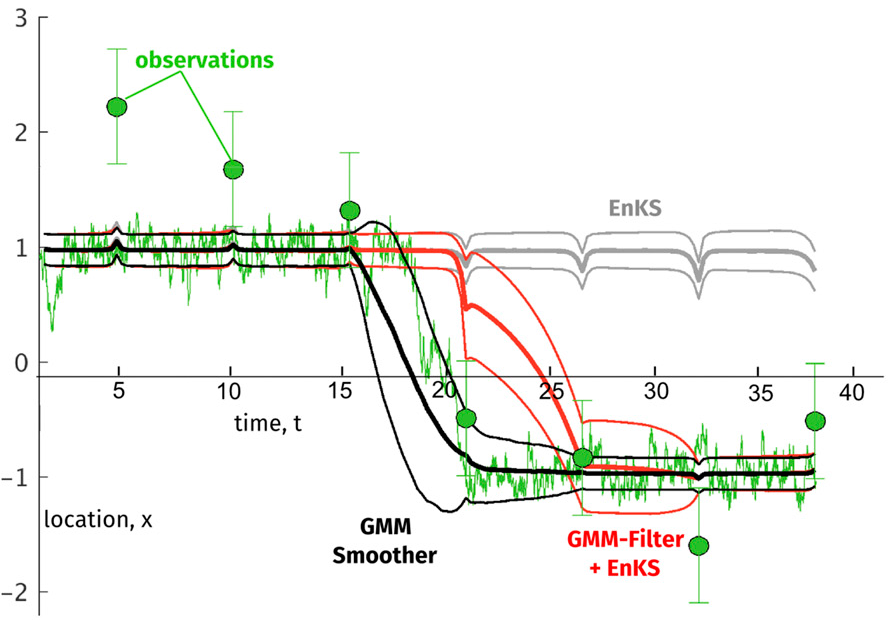Interdisciplinary Nonlinear Bayesian Data Assimilation
|
P.F.J. Lermusiaux, P.J. Haley, Jr., M. Doshi, J. Lin, W.H. Ali, A. Gkirgkis, A. Charous, Z. Duguid Massachusetts Institute of Technology
|
Project Summary Ongoing MIT-MSEAS Research Additional Links MSEAS Project-supported Publications Background Information
|

|
| This research is sponsored by the Office of Naval Research. | ||
Project Summary
Our long-term goal is to: generalize, develop, and implement our stochastic dynamically-orthogonal decompositions and nonlinear Bayesian filtering and smoothing schemes for principled probabilistic predictions and predictability studies of physical-acoustical-biogeochemical-sea-ice dynamics, and for interdisciplinary nonlinear Bayesian data assimilation, adaptive sampling, and quantification of observation needs for naval operations.
Background information is available below.
| Top of page |
Ongoing MIT-MSEAS Research
Specific Objectives:
- Develop, implement, and analyze our DO equations and numerical schemes for stochastic physical-acoustical-biogeochemical-sea-ice dynamics, including closures, retractions, and optimal adaptive reduced-order schemes.
- Further develop, implement, and analyze our interdisciplinary nonlinear Bayesian DA, including measurement models, mixture models and parameters, and state augmentation
- Apply our DO and GMM-DO schemes, as well as new theoretical extensions, numerical schemes, and distributed implementation, in idealized-to-realistic interdisciplinary dynamics conditions and observing system simulation experiments, quantifying entropy and information-flows, and the overall DA performance.
- Evaluate results using information-theoretic metrics, explain multiscale interdisciplinary dynamics, develop interdisciplinary adaptive sampling, and quantify observation requirements
- Collaborate and transfer data, expertise, approaches, algorithms and software to NRL and other colleagues. Utilize and leverage the MIT Naval Officer education program.
Publications
MSEAS Project-supported Publications
| Top of page |
Additional Links
| Top of page |
Background Information
Our research builds on years of modeling experience in multiple ocean regions for physical, acoustical, and biogeochemical studies. The MSEAS software (MSEAS Group, 2010, Haley et al., 2015) has been used for fundamental research and for realistic simulations and forecasts of fields and uncertainties in many regions of the world's ocean (Lermusiaux et al., 2006; Leslie et al, 2008; Onken et al, 2003, 2008; Haley et al, 2009; Gangopadhyay et al., 2011; Ramp et al., 2011; Colin et al., 2013; Kelly and Lermusiaux, 2016; Lermusiaux et al., 2011, 2017a,b). Practical applications include ocean monitoring (Lermusiaux et al., 2007); real-time acoustic predictions and data assimilation (Xu et al., 2008; Lam et al., 2009; Lermusiaux et al., 2010; Duda et al., 2011); biogeochemical-ecosystem predictions and environmental management (Besiktepe et al., 2003; Cossarini et al., 2009; Coulin et al., 2017); relocatable rapid response (e.g. Rixen et al., 2012; De Dominicis et al., 2014); path planning for underwater vehicles (Schofield et al., 2010; Lolla et al., 2014a,b; Lermusiaux et al., 2016); and, adaptive sampling (Lermusiaux, 2007; Heaney et al., 2007, 2016). MSEAS has been tested and validated in a wide range of real-time forecasting exercises. They include: AWACS and SW-06 (Haley and Lermusiaux, 2010; Colin et al., 2013); AOSN-II and MB-06 (Lermusiaux et al., 2006, Gangopadhyay et al., 2011; Ramp et al., 2011); QPE-08 and -09 (Lermusiaux et al., 2010; Gawarkiewicz et al., 2011; Lermusiaux et al., in prep.); PhilEx-08 and -09 (Agarwal and Lermusiaux, 2011; Lermusiaux et al., 2011); and NASCar and FLEAT (Lermusiaux et al., 2017a,b; Pan et al., 2018). Recently, we also issued forecasts of Lagrangian transports and coherent structures, and their uncertainties, on multiple time and space scales, as well as real-time guidance for optimal Lagrangian sampling (NSF-ALPHA). Using our ESSE methodology, we also forecast and transferred the probability of high-resolution ocean fields (sound-speed, currents, etc.) for three-dimensional underwater positioning system exercises (POINT). All of this expertise will be most useful. Although parameter tuning is always required, the present proposed research will leverage other efforts
| Top of page |


